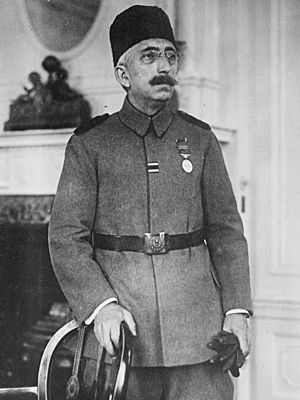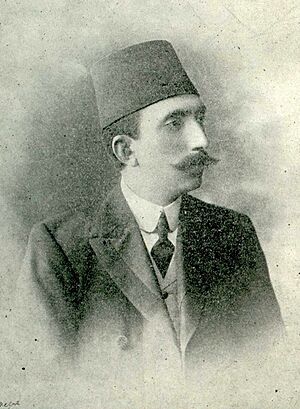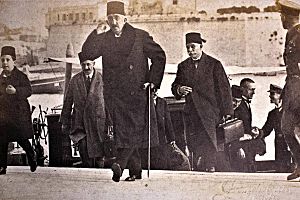Mehmed VI facts for kids
Quick facts for kids Mehmed VI |
|||||
|---|---|---|---|---|---|
| Ottoman Caliph Amir al-Mu'minin Custodian of the Two Holy Mosques Khan |
|||||

Mehmed VI in 1918
|
|||||
| Sultan of the Ottoman Empire (Padishah) |
|||||
| Reign | 4 July 1918 – 1 November 1922 | ||||
| Sword girding | 4 July 1918 | ||||
| Predecessor | Mehmed V | ||||
| Successor | Monarchy abolished | ||||
| Grand Viziers |
See list
Mehmed Talaat Pasha
Ahmed Izzet Pasha Ahmet Tevfik Pasha Damat Ferid Pasha Ali Rıza Pasha Salih Hulusi Pasha |
||||
| Ottoman Caliph | |||||
| Reign | 4 July 1918 – 19 November 1922 | ||||
| Predecessor | Mehmed V | ||||
| Successor | Abdulmejid II | ||||
| Head of the Osmanoğlu family | |||||
| Reign | 19 November 1922 – 16 May 1926 | ||||
| Successor | Abdulmejid II | ||||
| Born | 14 January 1861 Dolmabahçe Palace, Istanbul, Ottoman Empire |
||||
| Died | 16 May 1926 (aged 65) Sanremo, Kingdom of Italy |
||||
| Burial | 3 July 1926 Cemetery of Sulaymaniyya Takiyya, Damascus, Syria |
||||
| Consorts |
Nazikeda Kadın
(m. 1885; his d. 1926)Inşirah Hanım
(m. 1905; div. 1909)Müveddet Kadın
(m. 1911; his d. 1926)Nevvare Hanım
(m. 1918; div. 1924)Nevzad Hanım
(m. 1921; his d. 1926) |
||||
| Issue |
|
||||
|
|||||
| Dynasty | Ottoman | ||||
| Father | Abdulmejid I | ||||
| Mother | Gülistu Kadın (biological) Şayeste Hanım (adoptive) |
||||
| Religion | Sunni Islam | ||||
| Tughra |  |
||||
Mehmed VI Vahideddin (born January 14, 1861 – died May 16, 1926) was the last Sultan of the Ottoman Empire. He ruled from July 4, 1918, until November 1, 1922. The Ottoman Empire was a powerful state that lasted for centuries. It ended after World War I and was replaced by the modern country of Turkey.
Mehmed VI became the heir to the throne in 1916. This happened after the death of his cousin, Şehzade Yusuf Izzeddin. He was the oldest male member of the House of Osman, the ruling family. He became Sultan after his half-brother, Mehmed V, passed away. His father was Sultan Abdulmejid I.
Mehmed VI stepped down when the Ottoman Sultanate was officially ended in 1922. This led to the creation of the Republic of Turkey, with Mustafa Kemal Atatürk as its first president.
Contents
Early Life and Education
Mehmed VI was born in Constantinople (now Istanbul) on January 14, 1861. He was very young when his parents died. His father passed away when Mehmed was only five months old. His mother died when he was four.
He was raised and taught by his stepmother, Şayeste Hanım. He also had private teachers and attended lessons at a religious school called Fatih Madrasa. When he was 16, he moved out of his stepmother's home. He grew up with nannies, servants, and tutors. For 33 years, during the rule of his brother Sultan Abdul Hamid II, he lived in the Ottoman Imperial Harem (the royal living quarters).
As a young man, his closest friend was his cousin, Abdulmejid II. However, as they grew older, they became rivals. Mehmed was considered very close to Sultan Abdul Hamid II. This closeness later affected his views on politics. He strongly disliked the Young Turks and the Committee of Union and Progress political parties.
Mehmed enjoyed learning and took many private lessons. He read a lot and was interested in different subjects, including the arts. He learned calligraphy (fancy writing) and how to play the kanun, a musical instrument. He also studied Sufism, a branch of Islam. He secretly took courses on Islamic law, theology, and the Quran.
Reign as Sultan
Mehmed became Sultan after his half-brother Mehmed V died on July 3, 1918.
The First World War was a very difficult time for the Ottoman Empire. British and allied forces captured important cities like Baghdad, Damascus, and Jerusalem. Much of the Ottoman Empire's land was later divided among European allies. In April 1920, at the San Remo conference, France was given control over Syria. Britain gained control over Palestine and Mesopotamia (modern-day Iraq).
On August 10, 1920, Mehmed's representatives signed the Treaty of Sèvres. This treaty officially recognized these new controls and also made Hejaz (part of modern Saudi Arabia) an independent state.
The Sultan asked the existing government to resign and appointed Ahmed Tevfik Pasha to form a new one. The new government arrested leaders of the Committee of Union and Progress.
Meanwhile, a strong Turkish nationalist movement began to grow. This movement rejected the Treaty of Sèvres. A new government, called the Turkish Grand National Assembly, was formed in Ankara on April 23, 1920. This new government was led by Mustafa Kemal (Atatürk). They did not recognize Mehmed VI's rule.
Exile and Death
As the nationalist movement grew stronger, Mehmed VI and his family could no longer stay safely in the palace. The Grand National Assembly of Turkey officially ended the Sultanate on November 1, 1922. Mehmed VI was then asked to leave Istanbul.
On November 17, 1922, he left on a British warship called the Malaya. He did not take valuable items or jewelry, only his personal belongings. He went into exile in Malta. Later, he lived in Italy.
On November 19, 1922, Mehmed's cousin, Abdulmejid Efendi, was chosen as the new caliph. He became the head of the Imperial House of Osman as Abdulmejid II. However, the Caliphate was also ended by the Turkish Grand National Assembly in 1924.

Mehmed VI died on May 16, 1926, in Sanremo, Italy. His daughter, Sabiha Sultan, found money for his burial. His coffin was taken to Syria and buried in the cemetery of the Sulaymaniyya Takiyya in Damascus.
Personality
People who knew Mehmed VI described him as an optimistic and patient person. He was a kind family man in his palace. However, in public or at official events, he appeared serious and formal. He cared deeply about religious traditions. He was also intelligent and quick to understand things.
Mehmed VI was interested in literature, music, and calligraphy. He composed music that was played in the palace. His songs often expressed his longing for his home country. He was also a skilled calligrapher.
Honours
Ottoman Honours
- Order of House of Osman, Jeweled
- Order of Glory, Jeweled
- Imtiyaz Medal, Jeweled
- Order of Osmanieh, Jeweled
- Order of the Medjidie, Jeweled
Foreign Honours
- Prussia: Order of the Black Eagle of Prussia, October 15, 1917
Family Life
Mehmed VI had five wives, known as consorts.
Consorts
- Nazikeda Kadın (1866–1941): She was considered the last Ottoman Empress. She was from Abkhazia.
- Inşirah Hanim (1887–1930): She was from Circassia. She divorced Mehmed in 1909.
- Müveddet Kadın (1893–1951): She was known as a very sweet and kind-hearted woman. She had Mehmed's only son.
- Nevvare Hanim (1901–1992): She was the niece of Müveddet Kadın. She divorced Mehmed in 1924.
- Nevzad Hanim (1902–1992): She was Mehmed's favorite wife in his later years.
Sons
Mehmed VI had one son:
- Şehzade Mehmed Ertuğrul (1912–1944): His mother was Müveddet Kadın. He never married or had children.
Daughters
Mehmed VI had three daughters:
- Münire Fenire Sultan (1888): She died as an infant.
- Fatma Ulviye Sultan (1892–1967): Her mother was Nazikeda Kadın. She married twice and had one daughter.
- Rukiye Sabiha Sultan (1894–1971): Her mother was Nazikeda Kadın. She married Şehzade Ömer Faruk and had three daughters.
Images for kids
-
Departure of Mehmed VI from Dolmabahçe Palace after the abolition of monarchy, 1922
See also
 In Spanish: Mehmed VI para niños
In Spanish: Mehmed VI para niños







